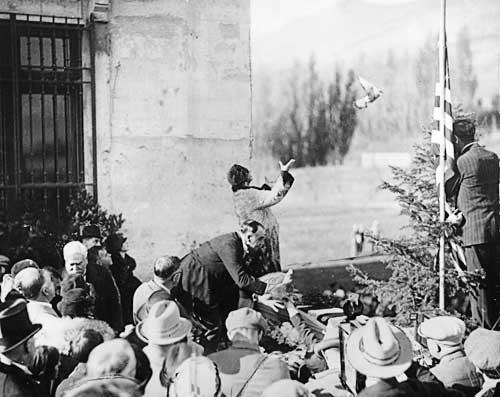
Queen Marie of Romania dedicating the still unfinished Maryhill Museum in 1926.
Eventually the world seems to show up on the doorstep of the Maryhill Museum of Art.
Which is a funny place for the world to show up, in this isolated concrete mansion overlooking the Columbia River Gorge in the semi-desert landscape of Klickitat County, Washington.
But look at the evidence. Marie, the bohemian queen of Romania, and Loie Fuller, the American dancer who was the toast of European arts circles around the turn of the twentieth century, were vital figures in the founding of the museum.
One of the museum’s signature collections is the ornate scenes of Theatre de la Mode, the post-World War II tableaux of design that helped get the French high-fashion industry back in gear and that features fantasies by, among others, the incomparable Jean Cocteau. Another important collection is the museum’s icon paintings, many from eastern Europe and Russia. It’s a long story, and worth hearing, but not right now.
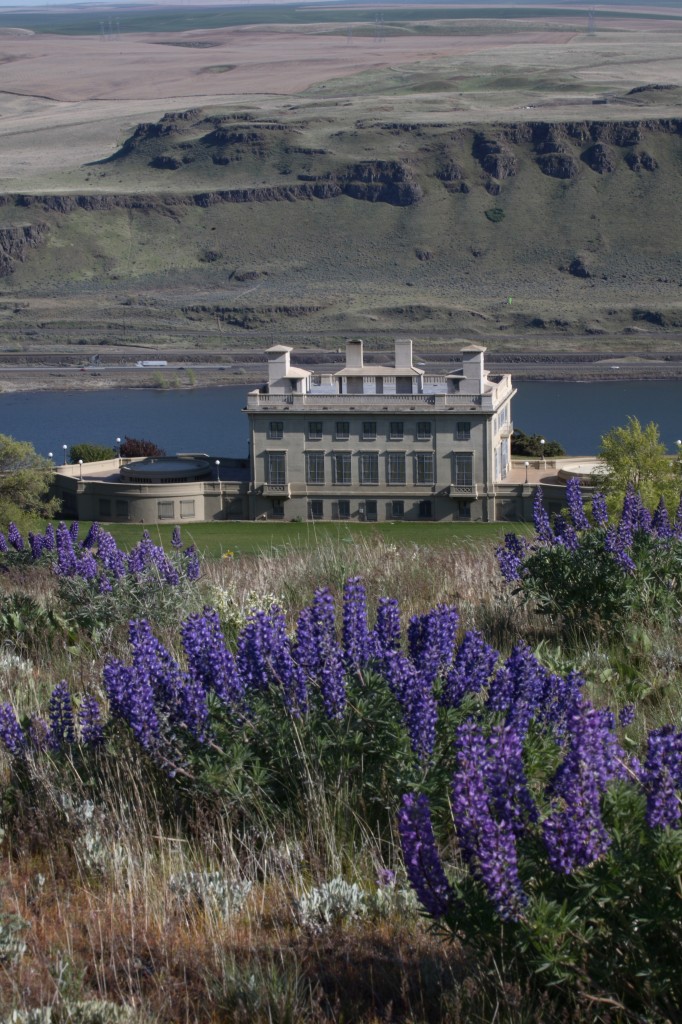 Partly because of weather and isolation, Maryhill is a seasonal museum, and it takes its annual break Nov. 15 before starting up again in spring, on the ides of March. That gives you a couple of weeks to make the drive out the Gorge: It’s a little more than 100 miles east of Portland, about the same distance as Eugene, but a much more interesting drive.
Partly because of weather and isolation, Maryhill is a seasonal museum, and it takes its annual break Nov. 15 before starting up again in spring, on the ides of March. That gives you a couple of weeks to make the drive out the Gorge: It’s a little more than 100 miles east of Portland, about the same distance as Eugene, but a much more interesting drive.
When Lee Musgrave arrived as curator of art from Los Angeles 14 years ago he brought a vision for contemporary art to amplify and complement the museum’s historic collections, which ranged from outright curios to engaging oddities such as a collection of global chess sets to some very good Rodins. Works by the likes of Red Grooms, Andy Warhol and Jeff Koons started popping up on the museum walls, plus pieces by a whole lot of contemporary Pacific Northwest artists.
Musgrave retired this summer, and his replacement, Steven L. Grafe, is just getting his feet dry. I’d say “wet,” except it doesn’t rain much at the Maryhill end of the Gorge, and Grafe already knows a lot of the territory.
Grafe arrives at Maryhill after almost six years at the National Cowboy & Western Heritage Museum in Oklahoma City, where he was curator of American Indian art. It was a good stop for a specialist in Native American art and culture. But Maryhill is very close to home.

Grafe earned his masters and doctoral degrees in art history from the University of New Mexico, where his doctoral dissertation was on pre-1880 beadwork from the southern Columbia River Plateau — an area of deep interest, not coincidentally, in the Maryhill collection. And he put in a couple of years as chief curator of the Southwest Museum of the American Indian in Los Angeles, in addition to curatorial stops at Mesa Verde National Park in Colorado and Cape Hatteras National Seashore in North Carolina.
He grew up in Salem, got his bachelor’s degree in studio art at Oregon State University, and has deep Northwest roots. His father’s family is from the Santiam area east of Salem, his mother’s family is from around Zigzag near Mt. Hood, and his wife went to Madison High School in Portland.
“She’s wanted to live at the east end of the Gorge since she was in high school,” Grafe said a couple of weeks ago when he was in town for a museum marketing meeting.
We talked at a coffee shop and bakery on Northeast Martin Luther King Jr. Boulevard, a part of town that’s changed markedly since the days when Grafe knew Portland well.
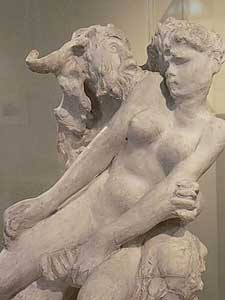
Grafe skipped the coffee, had a pastry and talked enthusiastically about his return to the Pacific Northwest. He seems smart, affable, and well-connected — and he’s in a place he wants to be. What’s the attraction of Maryhill? “Two things,” he said. “It’s the collections that are there, and the unique geography.”
He already knows a lot of the regional players from previous short stints at the Oregon College of Art and Craft in Portland and as acting curator of Native heritage at the High Desert Museum in Bend. And already he’s been getting around and seeing what’s up at other museums and galleries. He praised the comic-art exhibit Faster Than a Speeding Bullet: The Art of the Superhero at Eugene’s Jordan Schitzer Museum of Art, and when he discovered we’d both seen Comic Art Indigene, last year’s groundbreaking show of Native American comics art at the Museum of Indian Arts & Culture in Santa Fe, the conversation took a fascinating turn into his views on the realities and myths of contemporary Indian life.
Grafe has also been a consulting curator for the touring exhibit Craft in America: Expanding Traditions, a show that opened the Museum of Contemporary Craft‘s new home in the Pearl District and was the companion exhibit to PBS television’s series Craft in America. So between craft and Native American art he’s deeply familiar with two of Maryhill’s most important areas of interest.
Not that it’s all about nose-to-the-grindstone earnestness. “A certain amount of whimsy is a good thing,” he noted, and added: “A good curator has a gift for free association. You can put two things together and get that ‘aha!’ moment.”
Still, you have to know which two things your institution has that you can put together. Grafe inherits the subjects of next season’s program from Musgrave, who designed it before he retired, and the opener will be 70: Seven Decades of Collecting at the Maryhill Museum, a selection of 70 pieces from the museum’s permanent collections to highlight its 70th anniversary season.
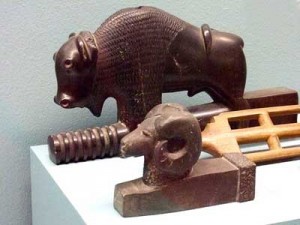
“The beauty of that for me is, I’m gonna get to learn the collection real well,” Grafe said. Those winter-break months are going to help that process considerably.
Also scheduled for 2010 is a selection of pieces by Northwest master glass artist William Morris, inspired by the flora and fauna of Steens Mountain and the Sisters area in Oregon, and the North Cascades in Washington.
The season’s third special exhibit will be Comics at the Crossroads: Art of the Graphic Novel, a show that takes advantage of the Pacific Northwest’s leadership in the contemporary graphic-novel movement. Are you sensing a theme here?
Grafe has ideas for beyond 2010, though nothing’s set yet. He’s looking at a traveling show of icons for 2013, an exhibit that would tie in well with the museum’s own holdings.
“That’s one part of the collection that I’d like to build on,” he said. “The Northwest is something of a center for icons.” Indeed, just north of the nearby town of Goldendale, Washington, lies the St. John the Forerunner Greek Orthodox Monastery, where making icons is one of the arts that the 20 nuns and novices practice.
Another possibility: a show of landscapes of the Columbia River region by Eanger Irving Couse, a prominent member of the Taos Art Colony in New Mexico, whose wife grew up on a ranch east of Goldendale, where the two lived for four years beginning in 1897.
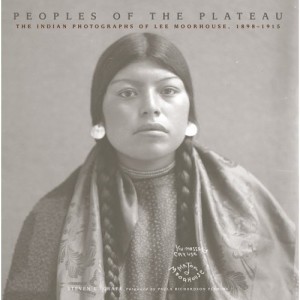
Grafe is thinking of a show of photographs by Lee Moorhouse, who was born in Iowa in 1850 and became a leading civic figure and photographer in the eastern Oregon ranch town of Pendleton, leaving 9,000 images of life in and around the city. Grafe knows Moorhouse well: In 2005 the Western Legacies Series published his book Peoples of the Plateau: The Indian Photographs of Lee Moorhouse, 1898-1915.
And Grafe has his eyes on a show that would center on a rare sketchbook that the Hudson River School painter Albert Bierstadt made during a trip through the Pacific Northwest on one of his many working sojourns in the West. Bierstadt has regional pop: His large romantic oil of Mt. Hood is one of the iconic paintings in the collections of the Portland Art Museum. And, of course, you can walk onto the Maryhill Museum grounds, look west over the Gorge, and see the eastern slope of Mt. Hood looming on the skyline. Bierstadt’s sketchbook, which would help tie his Northwest connections together, is at the Mabee-Gerrer Museum of Art in Shawnee, Oklahoma.
What else? Hard to tell. But it’ll be interesting for Grafe — and the rest of us — to find out.
PHOTOS, FROM TOP:
- Queen Marie of Romania dedicating the still unfinished Maryhill Museum of Art in a 1926 ceremony. The museum didn’t actually open to the public until 1940, after a push by Alma de Bretteville Spreckels, wife of the San Francisco sugar king.
- Maryhill Museum from above, with spring lupine. Photo: Nyland Wilkins
- Steve Grafe, Maryhill’s new curator of art
- Auguste Rodin, “The Minotaur,” 1886. Plaster. Photo: Mary Harrsch
- Native American stone figural pipes, 19th century. Photography: Mary Harrsch
- Grafe’s book on pioneer Pendleton photographer Lee Moorhouse.